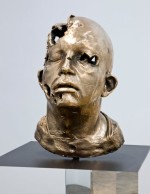Whitehot Magazine
April 2024
"The Best Art In The World"
"The Best Art In The World"
April 2024
January 2009, Julian Hoeber @ Blum & Poe

JULIAN HOEBER
BLUM & POE
LOS ANGELES
The two portions of Julian Hoeber's show at Blum & Poe are so formally different that I made the embarrassing mistake of asking who 'the other artist' was. In one room, 15 drawings, all based on the same black and white op-art spiral, line the walls. In the other, 10 golden portrait heads on mirrored pedestals crowd the floor. Both draw viewers in [magnetically] with their visual spectacularity; both seem to feed on pure fury.
Hoeber's spiral drawings are a personal retaliation against the 'postmodern' trend of pastiche which reigned supreme during the 80s and 90s [when he was in art school]. Black and white spirals on standardized sheets of paper each undergo slight alteration. I Don't Care... (2008) and Your Body is a Battleground, (2008) superimpose Roy Lichtenstein speech bubbles on the op-art spirals; Centered Tit (2008) features a clip of a Lucien Freudian breast 'stuck' to the heart of the vortex with trompe l'oeil paper and tape; and in Cezanne Rorshach (2008) an abstract, inkblot-like form disrupts the regularized spiral as tiny Cezanne reproductions hover round the edges.
A searing textual critique accompanies the show. 'The best model of a person is a tube. Stuff goes in and stuff comes out', writes Hoeber. His spirals are at once an acknowledgment of 'what went into his tube' and an audacious declaration that he reserves the right to lay out his personal experience in any way he pleases. Hoeber's spirals are a challenge to those who pursue bricolage for bricolage's sake alone; but he also bites his thumb at their willing dupes, at the eager participants in his own little game of art historical in-jokes.
His iridescent bronze busts, consciously splendid and shot through with bullet holes, establish his own right to issue such a challenge. Using 'totally classical forms', as he puts it, Hoeber still manages to create objects -- in fact, an entire space -- whose impact is entirely novel. Bald casts of himself and a female model are mounted on mirrored pedestals. Facial details -- pores and wrinkles and hairs -- are hardened and gilded into perfection. But there is a softness, a fleshiness, to them that is only revealed as a result of the destruction they have undergone. Evidently shot at while still in soft clay form (before being cast into metal), some of the visages collapse in on themselves; others remain nearly intact. In one, a modern-day Minerva springs, fully-formed, from inside another head.
It is far too simplistic to describe Hoeber's sculptures as mindlessly 'violent': they are both thought-out and quick-witted. Though freed of his spirals' more adolescent irreverence, Hoeber's sculptures still convey a certain impatience with artists' unthinking engagement with past forms, implying through his own work that simple laziness is no excuse.
1.JPG)
Sarah Neel Smith
Sarah Neel Smith is a writer in Paris.
sarah.neel.smith@gmail.com









